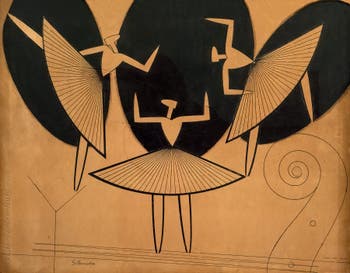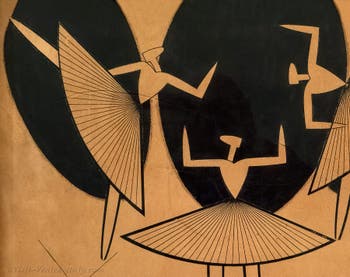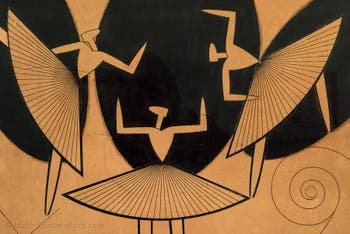Guggenheim Artists | Location | Opening Hours Tickets | Authorizations
Artists Picasso | Pollock | Braque | Calder | Chagall | Dalí | Ernst | Kandinsky | Léger | Magritte | Miró | Modigliani | Brancusi | Brauner | Campigli | Chirico | Delaunay | Delvaux | Duchamp | Fini | Hartung | Kooning | Laurens | Malevich | Man Ray | Masson | Marini | Mondrian | Pegeen | Pevsner | Picabia | Tanguy | Tapies | Twombly | Warhol
Man Ray “Silhouette” at the Peggy Guggenheim Collection in Venice

Man Ray, Silhouette Painting - Ink and Charcoal on Cardboard (51.6 x 64.1 cm) 1916
Man Ray was born in 1890 in Philadelphia and moved with his family to New York, where he discovered Alfred Stieglitz's "291" gallery.
His first solo exhibition held in 1915 at the Daniel Gallery in New York.
From that date, Man Ray began to turn to photography, which will give him worldwide fame.
In 1916 he became friends with Marcel Duchamp, with whom he founded the "Société des Artistes Independants", then, in 1920, the "Société Anonyme" with Marcel Duchamp, Henry Hudson, Andrew McLaren and Katherine Dreier.

Man Ray, Silhouette In 1921 Man Ray settled in Paris and published with his friend Duchamp the first and only copy of the magazine "New York Dada".
In 1925, Man Ray participated in the first Surrealist Exhibition in Paris at Galerie Pierre, alongside Giorgio de Chirico, Pablo Picasso, Jean Arp, Max Ernst, Joan Miró and André Masson.
His painting "Silhouette" exhibited at the Peggy Guggenheim Collection was made in 1916, just after he abandoned his romantic, expressionist and cubist style.
Following his friend Marcel Duchamp and Francis Picabia, he turned towards a more graphic style, made of flat and repetitions in a play of black on white contrasts.
The dancer of “Silhouette” corresponded to his new passion for photography and his skills for freezing the movement.

Man Ray, Silhouette In “Silhouette”, Man Ray shows three positions of the same dancer at once in three places with three corresponding shadows, all very graphically represented and positioned in space.
His dancer is not alone; she dances with accompanying music, the music of which she is the subject and author at the same time.
The horizontal lines at the bottom of the work represent the strings of the instrument, strings on which she dances by creating the music that makes her dance.
The lower-left corner is a music stand at which the instrument's volute turns in the lower right corner.
This picture is an exceptional work: the arms' position, legs, skirt and shadows provide powerful and almost infinite movement to the painting.
Artists Picasso | Pollock | Braque | Calder | Chagall | Dalí | Ernst | Kandinsky | Léger | Magritte | Miró | Modigliani | Brancusi | Brauner | Campigli | Chirico | Delaunay | Delvaux | Duchamp | Fini | Hartung | Kooning | Laurens | Malevich | Man Ray | Masson | Marini | Mondrian | Pegeen | Pevsner | Picabia | Tanguy | Tapies | Twombly | Warhol
Guggenheim Artists | Location | Opening Hours Tickets | Authorizations
Back to Top of Page

